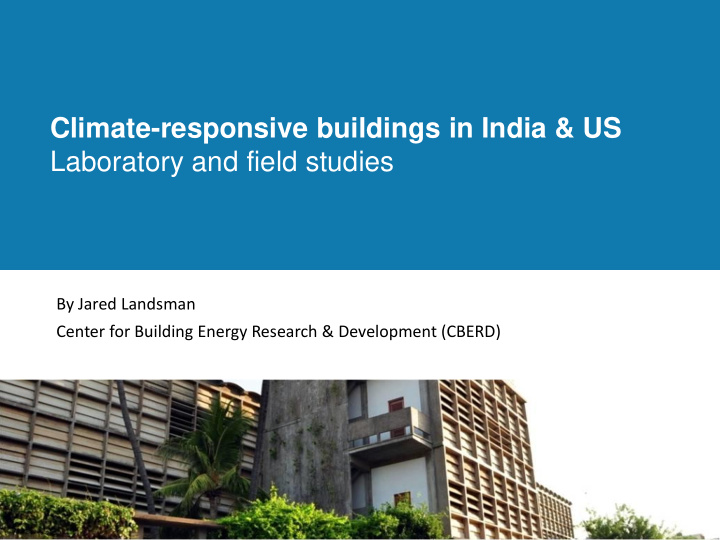



Climate-responsive buildings in India & US Laboratory and field studies By Jared Landsman Center for Building Energy Research & Development (CBERD)
Background: What is CBERD? Objective Promote energy efficiency in both India and the U.S. through collaborative research, with a focus on commercial and multi-family residential buildings Background Part of larger initiative: U.S.-India Partnership to Advance Clean Energy (PACE) 5-year project: 2012-2017 R&D Partners: • Five in U.S., led by LBNL • Six in India, led by CEPT University Funding US DOE and Government of India 2
CBERD organization Task 1: Simulation and Modeling LBNL, UCB, IIIT, CEPT Task 2: Monitoring & Benchmarking LBNL, CEPT Task 3: Integrated Sensors & Controls LBNL, RPI, IIIT, IIM Task 4: Advanced HVAC ORNL, MNIT, IIT Task 5: Building Envelopes LBNL,ORNL, CEPT, IIIT Task 6: Climate Responsive Bldgs UCB, CMU, MNIT, CSR, CEPT Cross Cutting Integration CMU, LBNL, CEPT Blue = US; Red = India 3
Task 6: Climate responsive buildings Objective Better understand performance of well designed passive buildings; focus on: o Natural ventilation & mixed-mode o Thermal mass & nighttime ventilation o Role of air movement Activities 1. Physical Performance a) Earth air heat exchangers (monitoring & simulation b) Mixed-mode case studies c) Building monitoring (India & US) 2. Thermal Comfort a) Climate analysis & new bioclimatic chart b) Field-based IEQ surveys c) Laboratory studies 4
Monitoring in India 5
Monitoring in India Completed year-long monitoring of indoor/outdoor thermal conditions: • Air temperature • Humidity • Globe & surface temperature HOBO data loggers Instrumentation – temperature & humidity & radiant • Long term monitoring: Hobo data loggers • Instantaneous measurements: Testo 410 & Extech HT 30 Currently conducting comfort & performance analysis Extech HT30 Heat Stress Test 410-2 compact vane meter anemometer - radiant temperature – temperature, humidity (from globe & air temp) & air velocity 6
Monitoring in India - Auroville 7 naturally ventilated buildings in a hot & humid climate, small commercial & some residential • Thermal mass • Ventilated cavity walls & roof • Dome (stack effect) • Courtyard • Insulation Annual Air Temperature Profile 42 Temperature ( ° C) 34 26 18 10 Nov Dec Jan Feb Mar Apr May Jun Jul Aug Sep Oct Month Outdoor Indoor Annual air temperature profile of building using thermal mass and night ventilation scheme 7
Monitoring in India – Mixed Mode 6 mixed mode buildings across India’s climate zones, larger commercial bldgs External shading Operable windows Evaporative cooling Radiant cooling Thermal chimneys Evaluation of instantaneous indoor operative temperature based on the IMAC and ASHRAE-55 adaptive models 8
Chamber comfort study in India Coordinated study in “thermally controlled chamber” Impact of air movement on thermal comfort in hot & humid environment Personally controlled fans 8 different thermal conditions Chamber furniture layout Chamber HVAC rendering Airmate S35113R Pedestal Fan 9
Chamber comfort study in India Developed work plan and experiment schedule Experiment schedule A B 15min 1 hr 20 min (15+30+5+30) 8:45- 9:00- Dt Time 9:15-9:45 9:50-10:20 9:00 9:15 session 1A session 1B Day 1- 26˚C/60% dd/mm/yyyy 26˚C/60% 26 ˚ C/60% Session acclimatize Survey |Y/N |Y/N |Y/N Y/N| |Y/N |Y/N |Y/N Y/N| prep. Subject No 1+2 1 2 1 2 Example of work plan 10
Chamber comfort study in India Calibrated all equipment Measured air velocity and fan power Fan A Power & Air Velocity 25 2.00 Air Velocity @ 1.1m (m/s) 20 1.60 Power (W) 15 1.20 10 0.80 5 0.40 0 0.00 1 2 3 4 5 6 7 8 9 10 11 12 13 14 15 16 17 18 19 20 21 22 23 24 Fan Setting Power Air Velocity Fan power and air velocity TESTO 480 for air velocity measurement 11
Chamber comfort study in India 20 subjects acclimated to hot Indian climate Typical Indian summer clothing Administered experiments with human subjects Subject in chamber experiment Survey questions 12
Preliminary findings: Chamber study in India People prefer a wide range of air speeds Important to give people individual control 13
To what extent does air movement compensate for hot & humid conditions? 14
Preliminary findings: Chamber study in India At least 90% thermal acceptability up to 32 ° C (89.6 ° F), 60% RH 100% 100% 100% 95% 93% 100% 90% 55% 15
Preliminary findings: Chamber study in India Air movement allowed people to stay thermally neutral up to 32 ° C (89.6 ° F), 60% RH v (m/s) Mean .22 .24 .74 .77 .81 .89 1.03 1.38 Range 0 - 1.36 0 - 0.95 0 - 1.32 0 - 1.52 0 - 1.58 0 - 1.5 0 - 1.52 0 - 1.6 16
Preliminary findings: Chamber study in India Over 25% of subjects still prefer to feel cooler at 28 ° C (82.4 ° F), increasing as it gets hotter 9% 9% 30% 32% 44% 32% 55% 76% 17
Chamber study in India – Next steps Compare with other studies using SET 9% 9% 30% 32% 44% 32% 55% 76% India Study (Pedestal Fan) US Study (Pedestal Fan) US Study (Ceiling Fan) 18
Questions?
Recommend
More recommend